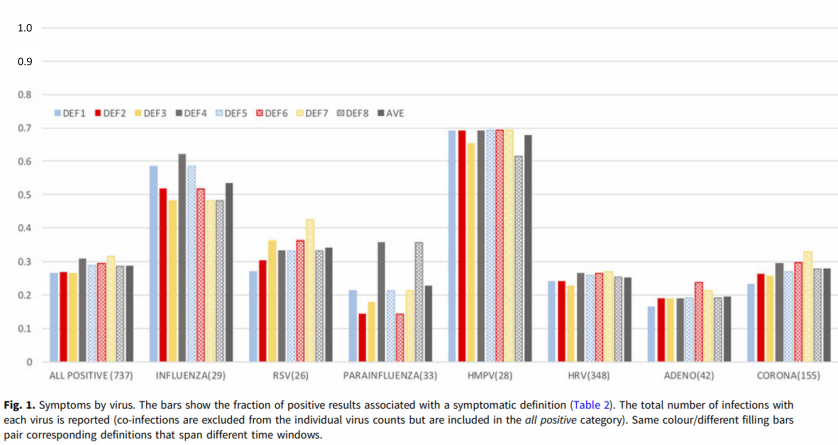When I wrote my scientific review of the seasonality of respiratory illness in Medical Hypotheses (2016) I devoted several paragraphs to trying to show that respiratory viruses could become dormant, lurking unseen in their human hosts without producing symptoms, and that they could be reactivated, often after changes in ambient temperature. I did this because at that time many scientists didn’t accept that the common respiratory viruses could sometimes become dormant. In fact I was spurred on to write the article by a conversation that I had with a famous UK virologist; she told me that flu (as an example) was spread by an “endless chain of symptomatic individuals”. If I were to write that article now, I would cut out most of that section and just cite a paper that came out last year, describing the work done by scientists at Columbia University [1]. They tested residents of New York City for the presence of respiratory viruses throughout the year, whether or not they showed symptoms of a cold or flu. The results were remarkable. First, they found that roughly 60% of people carrying respiratory viruses were asymptomatic. Second, they found that people carried these viruses year-round: as many tested positive in summer as in winter.

We’d like to make predictions of the likely course of epidemics such as Covid-19, so we’d like to understand the seasonality of the well-established human viruses. Therefore we need data about the seasonality of the presence of the virus. But we also want data about the seasonality of the illnesses caused. We’re going to want models, but they need to be more complicated, with a visible component – representing the people who are sick – and also a hidden component representing the asymptomatic cases where the virus is lurking undetected.
We will need to rethink our picture of respiratory illnesses in the light of the Columbia University studies. We can now see that respiratory infections are very largely asymptomatic and that respiratory viruses are, to a great extent, symbiotic. The body seems to get rid of them periodically, presumably when they get a little out of hand – often after chilling of the individual or cold weather. In any case, viruses were detected in only 17% of samples collected, suggesting that these infections come and go. Maybe the function of a cold is to have a clear-out of respiratory viruses and prevent more serious illnesses that might arise if the virus were to mutate and become virulent (it might, for example, lose some of its temperature-sensitivity).
For more thoughts on the Columbia University study and its implications for the mechanisms that underlie the seasonal appearance of respiratory illnesses click here.
Patrick Shaw Stewart, 9-14 May 2020
[1] Galanti, M., et al. “Rates of asymptomatic respiratory virus infection across age groups.” Epidemiology & Infection 147 (2019).
[2] Price, Rory Henry Macgregor, Catriona Graham, and Sandeep Ramalingam. “Association between viral seasonality and meteorological factors.” Scientific reports 9.1 (2019): 1-11.
Other papers on the NYC study:
Birger, Ruthie, et al. “Asymptomatic shedding of respiratory virus among an ambulatory population across seasons.” mSphere 3.4 (2018): e00249-18.
Galanti, Marta, et al. “Longitudinal active sampling for respiratory viral infections across age groups.” Influenza and Other Respiratory Viruses 13.3 (2019): 226-232.
_____________________
The TDVT Hypothesis, as explained by my friend Brian.
For a general discussion of the seasonality of respiratory viruses, written for the layperson, please see Every winter, colds and flu increase.
One thought on “Those troublesome asymptomatic infections (not just Covid-19)”